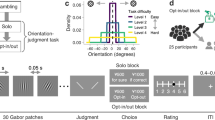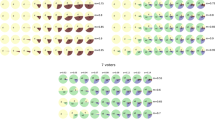Abstract
This study examines a group performing multiple tasks, with each subgroup performing each task expressed as a binary choice problem. Each subgroup uses the simple majority rule; a correct decision benefits the subgroup. This study demonstrates that, assuming all individuals’ equal competence for all tasks and a sufficiently large group size, when each individual’s probability of making a correct decision exceeds one-half, the optimal group composition is an equal number of individuals per subgroup. Conversely, it is less than one-half, the assignment produces the lowest benefit. We also find that when decision-making costs exist, if the competence is greater than one-half, the possibility that the performance of division of labor outweighs that of plenary voting increases as the cost increases. On the other hand, if the competence is less than one-half, division of labor is always more beneficial than plenary voting. The optimal group compositions for the cases where the group size is not sufficiently large are also discussed.

Similar content being viewed by others
Notes
But if a single voter with competence \(p(>\)1/2) is added to an odd-sized group in which voters with competences p and 0.5 are mixed, the majority vote accuracy of the group increases (Ben-Yashar and Zahavi 2011).
The intuition for this fact can be obtained immediately by analyses in Berg (1997) even though he deals with the performance of a group using hierarchical nested majority rule.
The algorithm to find these actual thresholds is as follows: First, we check which case occurs when the cost takes the value of approximated result. In the case of \(p = 0.7\), we found that \(c = 0.3316\) causes Case 3, i.e., \(D( m )>0\) for all m. Second, to know a rough threshold value, we decrement the figure of the order of \(10^{-2}\) of c by one until Case 2 is caused. In the case of \(p= 0.7\), we found that when c ranges from 0.3316 to 0.3016, \(D( m )>0\) for all m, but when \(c = 0.2916\), \(D( m )<0\) for some m. This means that the actual threshold should be located between 0.2916 and 0.3016. Thus, we start the next step from the value closer to the approximated threshold (in the current case, 0.3016 is selected). Continuing this procedure also for \(10^{-3}\) and \(10^{-4}\), we will obtain the threshold shown in the main text. If in the first step Case 2 occurs, we search a rough value by increasing the figure of the order of \(10^{-2}\) until Case 3 is caused.
A model in Section 2 of Bovens and Beisbart (2007) also indicates that the equal-sized group division leads to both high expected benefits of members and the equality among subgroups’ expected benefit under the assumption of more sophisticated agents although the framework of the model is different from that of Condorcet’s jury theorem.
By interpreting the notion of voting not as an aggregation of self-interested preferences, but as a process of searching for truth, which leads to the common good of society, Rousseau considered that the voting result declares the general will (Groman and Feld 1988). However, he did not formulate this argument. Groman and Feld (1988) insist that Condorcet’s jury theorem shares some assumptions with Rousseau’s argument and is helpful to clarify the theory of the general will. Ladha and Miller (1996) put their theorem in the context of this relationship between Rousseau’s general will and Condorcet’s jury theorem. For that reason, their study focuses not on the decision accuracy of subgroups but on that of the entire society.
References
Austen-Smith, D., & Banks, J. (1996). Information aggregation, rationality and the Condorcet jury theorem. American Political Science Review, 90, 34–45.
Ben-Yashar, R., & Danziger, L. (2011). Symmetric and asymmetric committees. Journal of Mathematical Economics, 47, 440–447.
Ben-Yashar, R., & Danziger, L. (2014). On the optimal composition of committees. Social Choice and Welfare, 43, 973–980.
Ben-Yashar, R., & Nitzan, S. (2001). The invalidity of the Condorcet jury theorem under endogenous decisional skills. Economics of Governance, 2, 243–249.
Ben-Yashar, R., & Zahavi, M. (2011). The Condorcet jury theorem and extension of the franchise with rationally ignorant voters. Public Choice, 148, 435–443.
Berg, S. (1997). Indirect voting systems: Banzhaf numbers, majority functions and collective competence. European Journal of Political Economy, 13, 557–573.
Berg, S., & Paroush, J. (1998). Collective decision making in hierarchies. Mathematical Social Sciences, 35, 233–244.
Boland, P. J., Proschan, F., & Tong, Y. L. (1989). Modelling dependence in simple and indirect majority systems. Journal of Applied Probability, 26, 81–88.
Bovens, L., & Beisbart, C. (2007). Factions in Rousseau’s Du Contrat Social and federal representation. Analysis, 67, 12–20.
Fey, M. (2003). A note on the Condorcet jury theorem with supermajority voting rules. Social Choice and Welfare, 20, 27–32.
Groman, B., & Feld, S. L. (1988). Rousseau’s general will: A condorcetian perspective. American Political Science Review, 82, 567–576.
Ladha, K. K. (1992). The Condorcet jury theorem, free speech, and correlated votes. American Journal of Political Science, 36, 617–634.
Ladha, K. K., & Miller, G. (1996). Political discourse, factions, and the general will: Correlated voting and Condorcet’s jury theorem. In N. Schofield (Ed.), Collective decision-making: Social choice and political economy (pp. 393–410). The Netherlands: Kluwer Academic Publishers.
List, C. (2005). The probability of inconsistencies in complex collective decisions. Social Choice and Welfare, 24, 3–32.
Nitzan, S. (2009). Collective preference and choice. Cambridge: Cambridge University Press.
Nitzan, S., & Paroush, J. (1982). Optimal decision rules in uncertain dichotomous choice situation. International Economic Review, 23, 289–297.
Owen, G., Grofman, B., & Feld, S. L. (1989). Proving a distribution-free generalization of the Condorcet jury theorem. Mathematical Social Sciences, 17, 1–16.
Tomiyama, Y. (1991). Decomposition of the group members into two-subgroups based on the correctness probability of collective choice: Two-decomposition theorem of the complete homogeneous group. Sociological Theory and Methods, 6, 69–84.
Tomiyama, Y. (1997). A new paradox in information pooling and optimal group decision making: An incompatibility between individual rationality and social rationality. Journal of Social and Information Studies, 4, 55–67.
Acknowledgments
The author is grateful to two anonymous reviewers for their helpful comments. The author is also greatly indebted to Naruto Nagaoka for his helpful suggestions that provided the foundation of arguments in Section 3.2. This work was supported by the Grant-in-Aid for Japan Society for the Promotion of Science Fellows Grant number 13J05358.
Author information
Authors and Affiliations
Corresponding author
Appendix: Proof of Fact 1
Appendix: Proof of Fact 1
Although this fact itself may have already been known, we could not find the proof of it. Thus, we here show the way to prove this fact using straightforward algebra. To do that, we refer to the method in Appendix of Tomiyama (1991), which is originally used to prove Eq. (18) in the present paper.
First, let us consider a group consisting of \(n\equiv 2k+1\) voters, where k is an integer. Then, the majority vote accuracy of this group is expressed as
Similarly, the majority vote accuracy of a group consisting of n + 1 voters is
Applying the well-known formula \(\left( {\begin{array}{c} x \\ y \\ \end{array}} \right) =\left( {\begin{array}{c} x-1 \\ y-1 \\ \end{array}} \right) +\left( {\begin{array}{c} x-1 \\ y \\ \end{array}} \right) \) to every term in the square brackets of (34), we have
Here, the sum of the first and second terms inside the square brackets is \(\left( {\begin{array}{c} 2k+1 \\ k+1 \\ \end{array}} \right) (1-p)^{k+1}\) because \(\left( {\begin{array}{c} 2k+1 \\ k \\ \end{array}} \right) =\left( {\begin{array}{c} 2k+1 \\ k+1 \\ \end{array}} \right) \). Then, the difference between the two majority vote accuracies,
is 0 because the inside of the curly brackets is 0 for every j. This ends the proof. \(\square \)
Rights and permissions
About this article
Cite this article
Sekiguchi, T. Optimal group composition for efficient division of labor. Theory Decis 81, 601–618 (2016). https://doi.org/10.1007/s11238-016-9552-1
Published:
Issue Date:
DOI: https://doi.org/10.1007/s11238-016-9552-1




